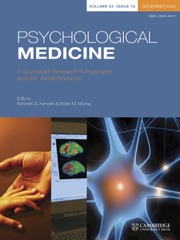Crossref Citations
This article has been cited by the following publications. This list is generated based on data provided by
Crossref.
Muñoz, Ricardo F
2010.
Using Evidence-Based Internet Interventions to Reduce Health Disparities Worldwide.
Journal of Medical Internet Research,
Vol. 12,
Issue. 5,
p.
e60.
Andersson, Gerhard
2010.
The promise and pitfalls of the internet for cognitive behavioral therapy.
BMC Medicine,
Vol. 8,
Issue. 1,
Ayers, Beverley
Mann, Eleanor
and
Hunter, Myra S
2011.
A randomised controlled trial of cognitive-behavioural therapy for women with problematic menopausal hot flushes: MENOS 2 trial protocol.
BMJ Open,
Vol. 1,
Issue. 1,
p.
e000047.
Carlbring, Per
Maurin, Tommy
Sjömark, Josefin
Maurin, Linda
Westling, Bengt E.
Ekselius, Lisa
Cuijpers, Pim
and
Andersson, Gerhard
2011.
All at Once or One at a Time? A Randomized Controlled Trial Comparing Two Ways to Deliver Bibliotherapy for Panic Disorder.
Cognitive Behaviour Therapy,
Vol. 40,
Issue. 3,
p.
228.
Barak, Azy
and
Grohol, John M.
2011.
Current and Future Trends in Internet-Supported Mental Health Interventions.
Journal of Technology in Human Services,
Vol. 29,
Issue. 3,
p.
155.
Possemato, Kyle
2011.
The Current State of Intervention Research for Posttraumatic Stress Disorder Within the Primary Care Setting.
Journal of Clinical Psychology in Medical Settings,
Vol. 18,
Issue. 3,
p.
268.
van Dam, Levi
and
Hoogendijk, Mel
2011.
Methodiek sociaalpedagogische hulpverlening.
p.
15.
Cuijpers, Pim
Andersson, Gerhard
Donker, Tara
and
van Straten, Annemieke
2011.
Psychological treatment of depression: Results of a series of meta-analyses.
Nordic Journal of Psychiatry,
Vol. 65,
Issue. 6,
p.
354.
van der Zanden, Rianne AP
Kramer, Jeannet JAM
and
Cuijpers, Pim
2011.
Effectiveness of an online group course for adolescents and young adults with depressive symptoms: study protocol for a randomized controlled trial.
Trials,
Vol. 12,
Issue. 1,
Andersson, Erik
Ljótsson, Brjánn
Hedman, Erik
Kaldo, Viktor
Paxling, Björn
Andersson, Gerhard
Lindefors, Nils
and
Rück, Christian
2011.
Internet-based cognitive behavior therapy for obsessive compulsive disorder: A pilot study.
BMC Psychiatry,
Vol. 11,
Issue. 1,
Woodford, Joanne
Farrand, Paul
Bessant, Michael
and
Williams, Christopher
2011.
Recruitment into a guided internet based CBT (iCBT) intervention for depression: Lesson learnt from the failure of a prevalence recruitment strategy.
Contemporary Clinical Trials,
Vol. 32,
Issue. 5,
p.
641.
Cuijpers, Pim
Donker, Tara
Johansson, Robert
Mohr, David C.
van Straten, Annemieke
Andersson, Gerhard
and
Hempel, Susanne
2011.
Self-Guided Psychological Treatment for Depressive Symptoms: A Meta-Analysis.
PLoS ONE,
Vol. 6,
Issue. 6,
p.
e21274.
Ridgway, Nicola
and
Williams, Chris
2011.
Cognitive behavioural therapy self-help for depression: An overview.
Journal of Mental Health,
Vol. 20,
Issue. 6,
p.
593.
Jones, Steven
Deville, Madeleine
Mayes, Debbie
and
Lobban, Fiona
2011.
Self-management in bipolar disorder: The story so far.
Journal of Mental Health,
Vol. 20,
Issue. 6,
p.
583.
Berger, Thomas
Caspar, Franz
Richardson, Robert
Kneubühler, Bernhard
Sutter, Daniel
and
Andersson, Gerhard
2011.
Internet-based treatment of social phobia: A randomized controlled trial comparing unguided with two types of guided self-help.
Behaviour Research and Therapy,
Vol. 49,
Issue. 3,
p.
158.
Johansson, Robert
and
Andersson, Gerhard
2012.
Internet-based psychological treatments for depression.
Expert Review of Neurotherapeutics,
Vol. 12,
Issue. 7,
p.
861.
2012.
Internet-based CBT improves fatigue severity, physical function and school attendance in adolescents with chronic fatigue syndrome.
Evidence Based Mental Health,
Vol. 15,
Issue. 3,
p.
81.
Danaher, Brian G
Milgrom, Jeannette
Seeley, John R
Stuart, Scott
Schembri, Charlene
Tyler, Milagra S
Ericksen, Jennifer
Lester, Whitney
Gemmill, Alan W
and
Lewinsohn, Peter
2012.
Web-based Intervention for Postpartum Depression: Formative Research and Design of the MomMoodBooster Program.
JMIR Research Protocols,
Vol. 1,
Issue. 2,
p.
e18.
Johansson, Robert
Hesser, Hugo
Ljótsson, Brjánn
Frederick, Ronald J
and
Andersson, Gerhard
2012.
Transdiagnostic, affect-focused, psychodynamic, guided self-help for depression and anxiety through the internet: study protocol for a randomised controlled trial.
BMJ Open,
Vol. 2,
Issue. 6,
p.
e002167.
van der Zanden, Rianne
Kramer, Jeannet
Gerrits, Rob
and
Cuijpers, Pim
2012.
Effectiveness of an Online Group Course for Depression in Adolescents and Young Adults: A Randomized Trial.
Journal of Medical Internet Research,
Vol. 14,
Issue. 3,
p.
e86.


